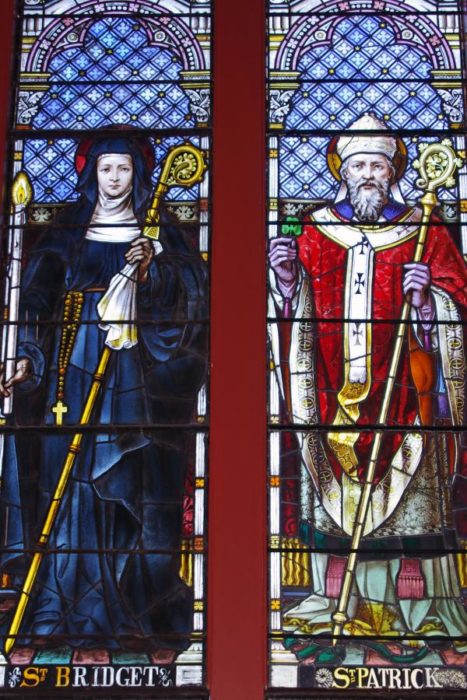A thought has been nagging at me for weeks now. I’ve wrapped my mental faculties round and round it, attempting to convince myself it’s just my imagination, but try as I might, it simply won’t go away. So here goes: As far as I can determine, the U.S. and Ireland are the only two countries in the world that have alter egos.
Before you decide I’ve gone totally off the deep end, take a moment and think about it. The U.S. has Uncle Sam and Lady Liberty. Ireland has Saints Patrick and Brigid. In both cases in both countries, the alter egos are both male and female, and in both cases in both countries mere mention of the illustrious personages’ names engenders tonnage of national character inferences. Can you think of any other nation that has such iconography? Neither can I.
In the scheme of things, the U.S. developed its alter egos very late in the game. Lady Liberty made her maternal debut in the late 19th century, offering shelter and sustenance to the world’s impoverished and persecuted. Uncle Sam made his first patriarchal appearance early in the 20th century when the country found itself thrust into World War.
Ireland, on the other hand, has had its alter egos for eons. Like the U.S., first on the scene was the woman. Hundreds of years before Brigid the Saint, there was Brid the Goddess. According to myth, Brid was born full-grown at sunrise in a house ablaze with light. A fiery column reached from her flame-red curls into the heavens. Beside the cottage flowed a stream whose waters had power to cure. On its banks grew healing plants. In the pasture grazed a red-eared cow whose sweet milk never ran dry. Goddess of fire, Brid was the patroness of hearth and home, smiths and forges, healers and herbs, poets and language. Druid priests lit fires in Brid’s name on the Celtic feast of Imbolc (February 1st) beseeching the goddess for an early spring. Priestesses tended a perpetual flame dedicated to the goddess in an oak grove on a hill in Leinster (now Kildare or “Place of the Oak”).
The historic Brigid lived 453-523 A.D. and, like many other women in those early days of Christianity, she was named in honor of Brid. Sired by a Celtic chieftain to a slave girl and foster raised by a Druid priest, Brigid was beautiful, gifted, and so strong-willed that when the Druid attempted to marry her off, she refused, choosing instead baptism by Saint Patrick and a life dedicated to charity.
Saint Brigid was warm-hearted, hospitable. and one of history’s earliest liberated women. She traveled widely, entertained with charm and grace, and was an excellent business manager, competently running an abbey which she built in Kildare on the very hill where Brid’s fire had burned for centuries.
Like her mentor Patrick, Brigid was fond of ale and is reputed to have been the best brewer in the land. She also kept the best dairy, where her cows gave more and better milk than any other in the land. The abbey became a way station for weary travelers, and its abbess, who miraculously fed multitudes of hungry beggars with very little, is revered as Ireland’s archetype of maternal care and hospitality. As such, her similarity to Lady Liberty is unmistakable.
Unlike our own Uncle Sam. Saint Patrick, though a patriarchal figure as well, did not gain his niche in history via a call to arms but rather a call to education. Son of a West Britain Roman family, at age sixteen Patrick was kidnapped by pirates and sold into slavery in Ireland. Six years later he escaped, and hired on as kennel master to a German boat transporting Irish wolfhounds to the continent. After many hardships, he returned to his family and entered the priesthood. When Rome sent an evangelical mission to Ireland, Patrick was a natural candidate for the job since he could speak Gaelic and was familiar with the Irish clan hierarchy.
At the age of 42, Patrick returned to Ireland as an ordained bishop. His plan was simple: Convert the chieftains and the people would follow. For twenty years Patrick spread the gospel, built churches, established schools, and sat with the high Kings at Tara to revise the Brehon Laws. In 450 A.D. he opened the first Christian college at Armagh. The magnitude of Patrick’s work is astounding. At a time when all construction was hand-hewn and mortared, he founded 385 churches and schools where thousands learned to read and write. After a lifetime of service, Patrick died on March 17, 463.
In transforming Ireland from a country with no written alphabet to a land of scholars. Saint Patrick gave the storytelling Irish the greatest treasure they could imagine. By the end of the 5th century, poems, sagas, and illustrated manuscripts were pouring forth from the vast Irish oral tradition. Saint Brigid, on the other hand, represents that which the Irish proudly proclaim as one of their most cherished national traditions: hospitality. From cottage to manor house throughout the land, guests are welcomed at hearth and table like long lost family members.
Ingrained in our consciousnesses as national symbols. Lady Liberty and Uncle Sam share the spotlight on July 4th, the day on which we celebrate all that is called “American Spirit.” Ireland does us one better. Each of its alter egos is honored individually on their own days of recognition. Although it is unknown when March 17th was first celebrated in Ireland, the date is now a nationwide holiday. Similarly, February 1st, the ancient festival honoring the goddess Brid, is nationally recognized as Saint Brigid’s Feast.
Perhaps it is more than merely an interesting coincidence that we. like Ireland, have adopted both female and male iconic figures. Call me daft, but with more than one-third of America’s population proudly proclaiming its Irish heritage, I truly think Brigid and Patrick had something to do with it. Slainte! ♦


Love this column.